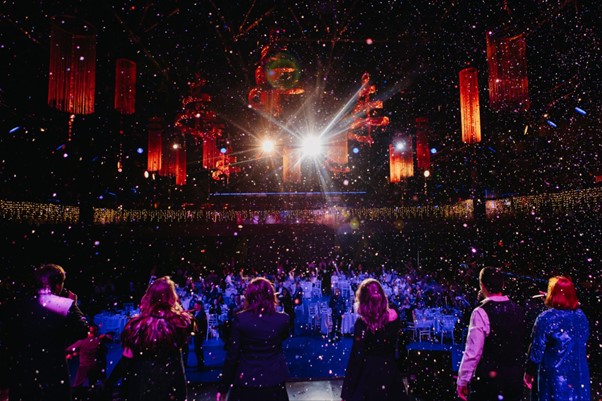Corporate events have long gone beyond simple team building activities. They address a wide range of tasks today: helping to accelerate onboarding, improving internal communications, increasing employee engagement and strengthening corporate culture. This is especially important for employees of remote teams who risk losing contact with each other and the company due to remote working formats.
In recent years, online tools have made communication easier and virtual offices have become a part of daily life. However, despite the convenience of digital solutions, companies still invest in offline events because face-to-face meetings create genuine connections that cannot be replaced by even the most advanced technologies. This is true even for IT teams.

Dinner for an IT team on the frozen Baikal lake
Ekaterina Liseycheva, Founder&CEO of the international event agency MandarinFox, describes how corporate events are changing and what is currently in demand among IT teams. She also shares her predictions about trends that will shape the market for events in 2025.
The first quarter of 2025 continues the trend of increasing demand for corporate events for remote multinational IT teams. The world is rapidly moving towards globalization, with more digital nomads and remote employees emerging from various corners of the globe. However, despite the existing variety of online tools, the quality of this interaction can vary. While online communication may be a comfort zone for some, it can be a source of frustration for others.
What is MandarinFox?
MandarinFox is an international event agency founded in 2016 that specializes in smart events. Drawing on nine years’ experience with a creative, personalized approach, the team develops and executes events that align with a company’s strategy, fostering employee and client retention through high engagement.

The MandarinFox team
The agency’s portfolio includes over 100 international projects, such as off-site strategy sessions, corporate events, festivals for up to 20,000 attendees, communication tools for staff adaptation, live broadcasts and video production. Among its clients are major global companies such as Tabby, KEK Entertainment, Nespresso, SkyEng, Ecco, CityMobile and others.
MandarinFox often works with distributed teams in the IT and GameDev sectors, or companies that have strong IT or FinTech companies. For these companies, measures to unite employees, such as calls and online meetings, are basic and typically handled internally. As a result, they more frequently turn to agencies for offline events, such as local meetups or for organizing gatherings for 100-500 key employees.
2025 trends: formats and activities
One of the most popular types of offsite events for IT teams in 2025 remains camps. This format combines a seaside children’s camp, scouting experience and outdoor retreat. Guests can expect a structured schedule, group activities, sports, arts, business activities with an educational component. Each team creates content for their own event independently, eliminating the feeling of coercion and encouraging participants to interact with one another and make shared memories. Additionally, shared breakfasts, morning exercises, places of residence and schedules foster closeness between team members. This addresses the client’s primary goal of uniting team members effectively.
Another key trend for offsite events is localization. This is a way to honor the country where the company operates. It’s important to understand that if remote teams are from different places, such as Portugal, Serbia, Armenia, and the United Arab Emirates, the event may take place in a hotel where people do not venture out, but still share a common story. The situation is different if most members of the hub are based in one location. For example, if it’s in Georgia, we have to explore monasteries, taste national cuisine and get acquainted with local culture.

Offsite event in Armenia: 4-day trip to Armenia for a unicorn company
Finally, a format where participants independently shape the activity plan and content of an event is gaining momentum. Of course, some clients ask not to involve employees and simply let them relax. However, more often, teams themselves show interest and willingness to participate in the preparation process. For example, some enjoy stand-up, others play musical instruments, and some are eager to share their experience in addressing management gaps. In such cases, the event program is built around the interests of the majority.
It’s also worth mentioning events with a competitive element, such as hackathons and case championships, which have become trendy formats for distributed multinational IT teams. Such formats not only solve business tasks, but also help people to unite through to, although not a long-term, but memorable and exciting interaction with each other, associating this experience with their company.
Among the variety of activities, participants typically highlight hands-on workshops (like making bracelets, key chains or molding clay mugs), small talk sessions, cozy campfire gatherings, sports and board games, team building exercises and even humorous predictions. However, at the preparation stage of designing the event plan, it’s crucial to consider the cultural background of the client’s audience.

Outdoor afterparty: CyberDacha for an IT Company
The main goals of such events are:
- To feel like a part of the company.
In remote work, employees can become isolated within their teams and projects, losing sight of the big picture. In-person meetings help them see the company as a unified organism and the contributions of colleagues from other departments. After the event, people usually continue interacting in group chats, sharing their impressions and bonding over shared experiences. Common memories help bridge communication gaps and speed up work processes.
- Emotional connections within the team.
Communication via chats or emails lacks emotional context, which often leads to misunderstandings or even conflicts. Emojis can make text feel more human, but overusing them risks creating an overly artificial or “too perfect” image. Face-to-face interaction, in turn, breaks down “digital blindness” and helps colleagues understand each other’s personalities and communication styles.

Team building outdoors: Jungle adventure
- A platform for experimentation.
Hackathons, case championships, TED-style talks, “failure story” sessions, and public speaking workshops — these events create opportunities for diverse forms of communication. It allows participants to exchange experiences and find solutions to specific work-related challenges.
- The “third place” concept.
The “third place” concept (a place outside the home and office for realization of the hobbies) is particularly relevant for IT and GameDev specialists. Art labs, hands-on workshops, music clubs and similar formats at corporate events provide excellent opportunities to fulfill the need for self-expression.
Corporate events from a business perspective
MandarinFox clients often measure event effectiveness through surveys, NPS scores, and employer branding metrics, making it easy to track results by comparing pre- and post-event data. If employees rate their understanding of the company’s strategy at 3/5 before an event and 5/5 points after, the impact is clear. Corporate events have become a way for businesses to demonstrate: “We are open and value you — treat clients and colleagues the same way.”
In-person meetings allow for instant audience feedback through microexpressions, emotions and direct dialogue, which is an antidote to “digital dissonance”. An added benefit is faster onboarding for new hires, who can join the team in a few days rather than weeks.
Finally, offline team building activities reveal hidden soft skills that indirectly influence work processes.

Making giant pizza as a format of team buildings activities
Challenges of organizing events for IT teams
IT audiences demand hyper-transparency and a gamified approach, with all activities having clear rules and measurable outcomes. It’s also important to incorporate values through “Easter eggs” and trendy memes tied to the team’s daily work life.
IT experts value clear instructions and Notion guides even more than transparency. Creating checklists like “What to pack for the flight” or “Where to go and what to find” is essential. Equally important is scheduling free time slots for relaxation and casual conversations.
It’s worth noting that IT teams often have a higher percentage of people who avoid open, active communication. However, this can be addressed by tailoring activities to employees’ preferences and hobbies.
Additional challenges for remote teams include flight delays. Coordinating arrivals from different locations and accounting for all transfers or delays can be tricky.
Pre-event engagement of participants
MandarinFox communicates with participants through channels familiar to the client’s team: Slack, Telegram, email, Facebook, and other platforms or messengers. The engagement process consists of three key components:
- Informational: Details like event location, timing, dress code, event map, and schedules.
- Motivational: Addressing “Why should I attend?” to eliminate doubts that the event is a waste of time.
- Gamification: Previewing offline activities online to create a space for initial interaction, networking, and discussions.
How to do: location, budget, team
We often hold corporate events for remote multinational IT teams in countries where the company has hubs. If there’s no fixed location, we prioritize countries or international cities with good transport and logistics access, such as UAE, Cyprus, Turkey, Armenia. We also take into account international political tensions, which may discourage some employees from travelling. The location choice also depends on the number of participants, as not every city can accommodate 400-500 people comfortably.
The average cost of a corporate event for 300–400 attendees is between €450,000 and €500,000. This includes flights, accommodation, and development of event concepts and content. The final costs depend on location, group size, season, and duration.
For smooth communication, MandarinFox always has a team member who speaks the local language or English, (if it’s widely spoken in the area). This ensures transparency and high quality execution.
In addition, one practice we strongly advocate — and many colleagues likely agree — is using AI tools. Neural networks speed up tasks like creating video travel reports or composing musical tracks inspired by inside jokes for team competitions.
Four rules for organizing a successful event
- Plan for everything (and then some).
In addition to the main plan A, always have backup plans B, C, and D ready.
- Provide participants with every detail.
People want to relax and avoid decision making during the event. Give them a detailed guide (e.g. schedules, maps, dress codes) to ensure they know what to expect and never feel lost. - Create the “I finally get it” feeling.
After the event, employees should have zero unanswered questions about the company’s strategy, product or team goals. Every activity and detail should reinforce these messages. - Be unforgettable.
Literally. Participants should leave with a unique shared experience—a story they’ll eagerly retell to others.

2024 New Year’s Eve Party for a Leading Telecommunications Company
The future of corporate events for distributed teams isn’t about choosing between online communication and in-person meetings — it’s about balancing both. Zoom meetings and team chats will remain the basis for daily work, but offline events will be the key factor preventing remote teams from becoming just a collection of avatars. Companies that realize this early will gain a significant advantage in the digital nomads era.
Also published on Medium.


